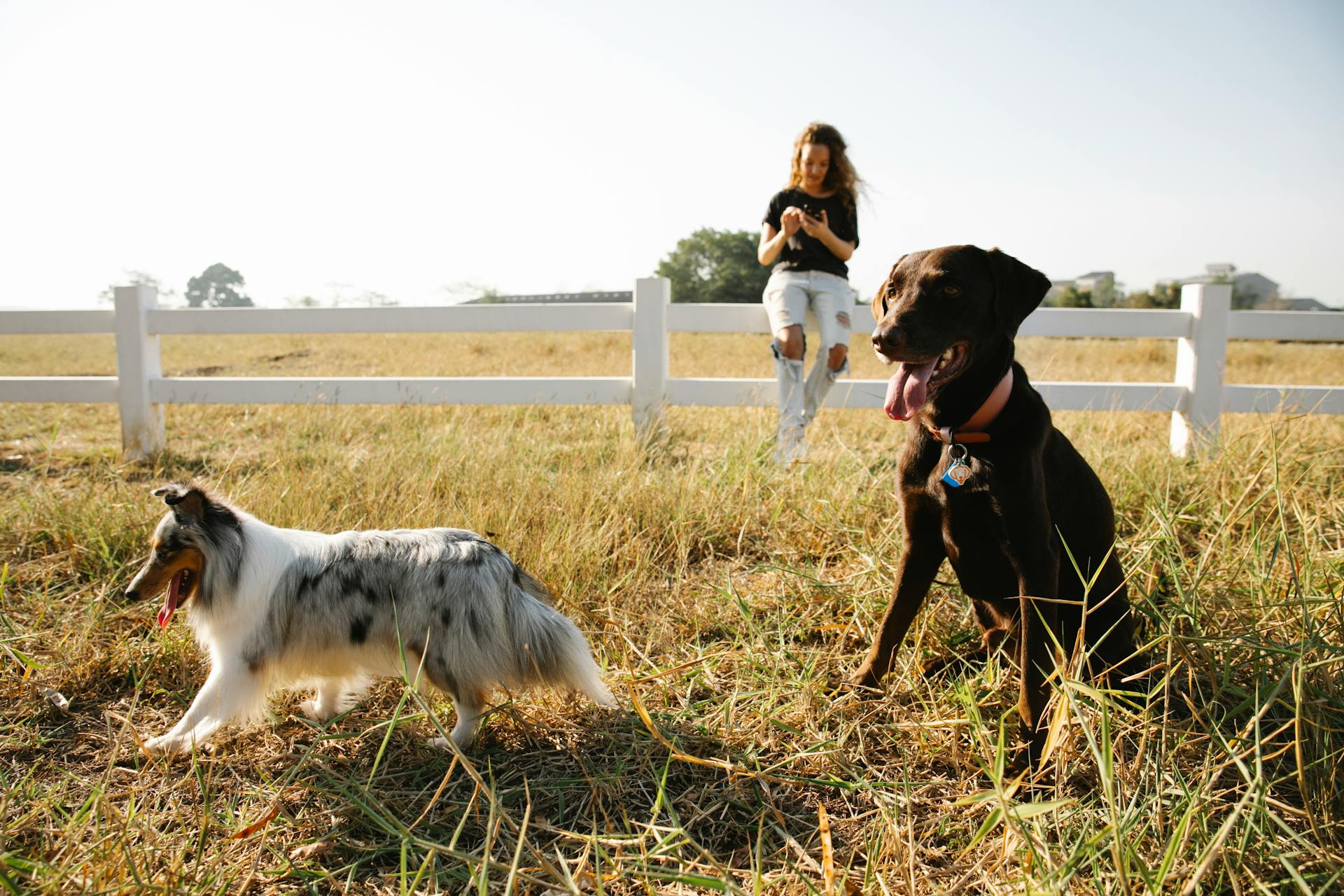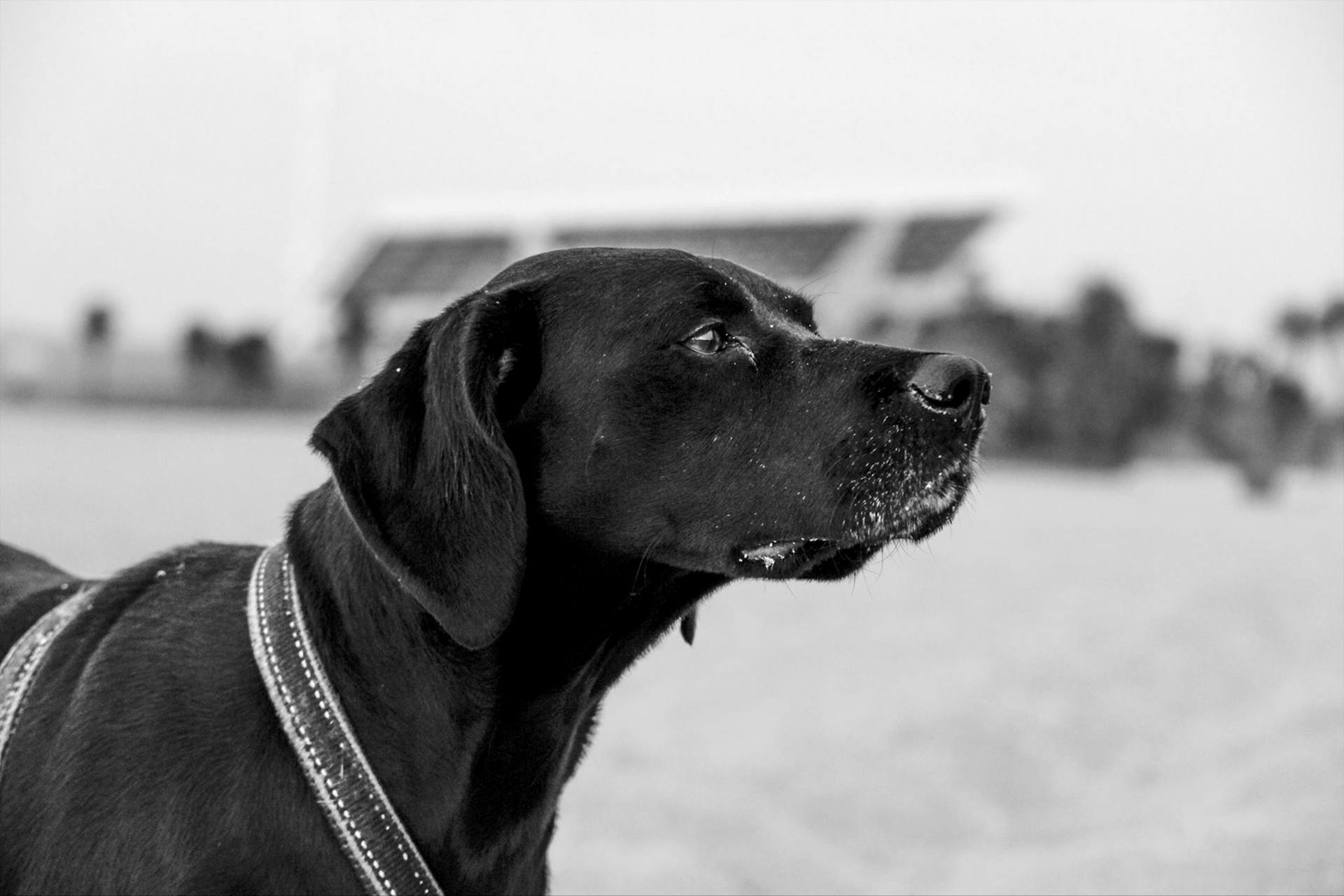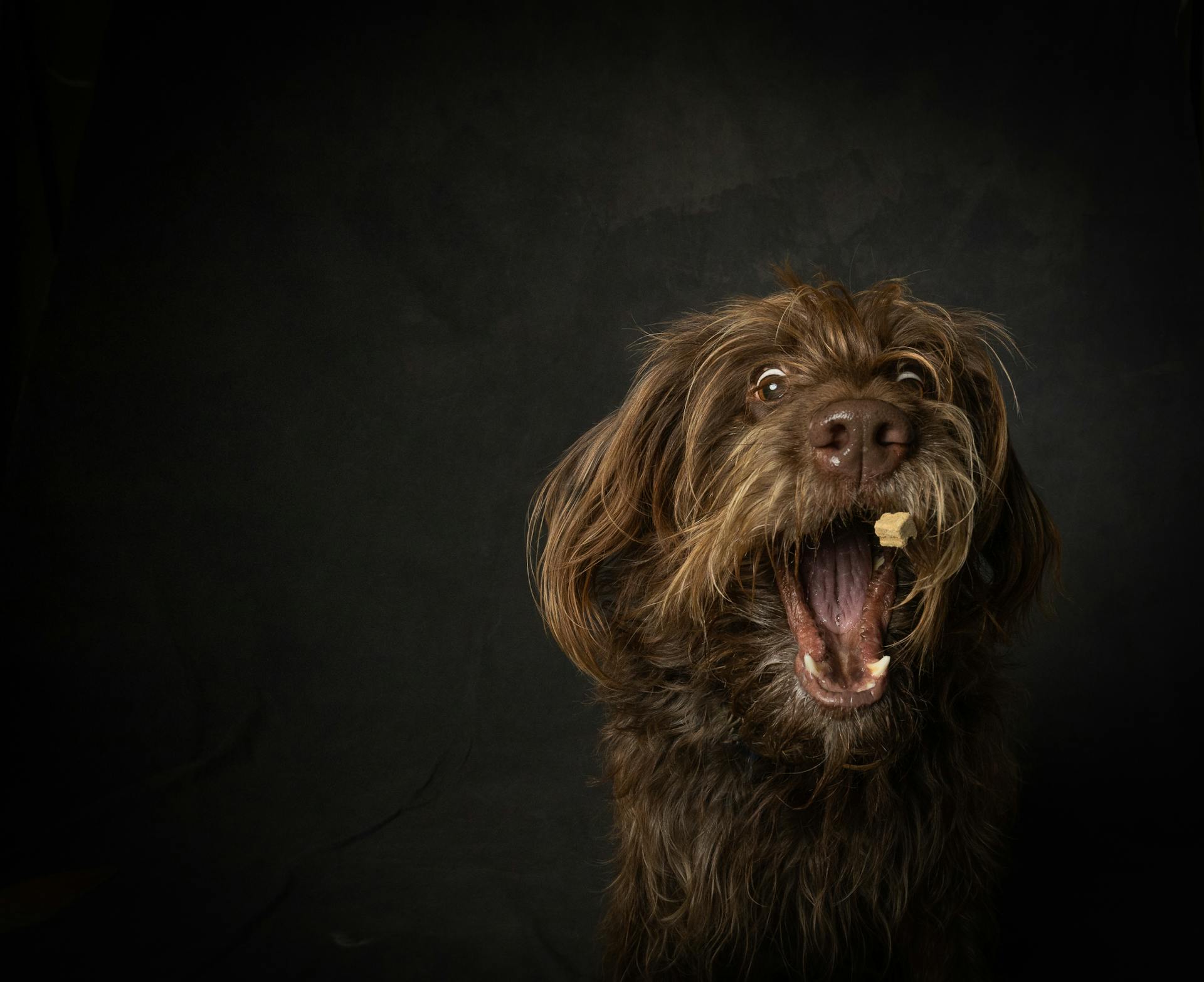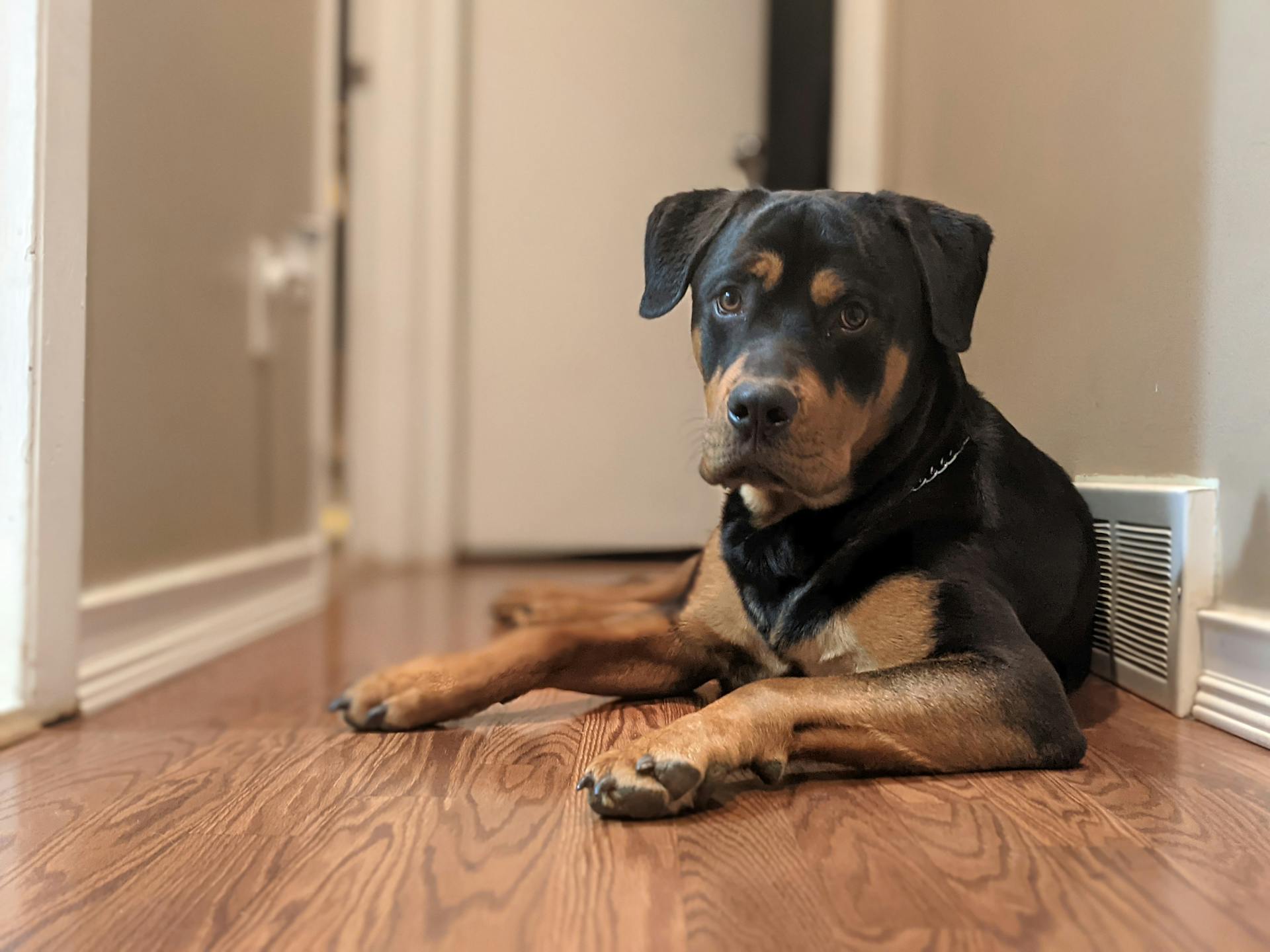
Labradors are one of the most popular breeds in the world, and as such, they require a diet that meets their unique nutritional needs.
Labradors are prone to obesity, so it's essential to monitor their food intake and ensure they're getting the right balance of nutrients.
A Labrador's ideal weight is between 55-80 pounds, and they should be fed according to their age, size, and activity level.
Labradors need a diet rich in protein, which can come from animal sources such as chicken, beef, or fish.
Nutrition Basics
Labradors need a nutritious diet to maintain a healthy weight, as obesity is a common problem in this breed.
Bone and joint issues are also common in labs, but a healthy weight can help prevent or manage these issues.
Start your lab off on a nutritious diet as early as possible to avoid them becoming overweight.
Labradors need a balanced diet that meets their nutritional needs, but it's also essential to monitor their food intake to prevent overeating.
A healthy weight for a lab can help prevent or manage bone and joint issues, making it essential to keep an eye on their diet and exercise habits.
A unique perspective: Chocolate American Lab
Choosing the Right Food
Choosing the right food for your Labrador is crucial for their overall health and well-being. To ensure your pup maintains a healthy weight, feed them food with a lower caloric density, which can be achieved by feeding them food higher in water and fiber.
Feeding your Labrador a balanced diet that contains both animal and plant-based foods is essential. This includes ingredients like lamb, turkey, and salmon, as well as grains, vitamins, and minerals.
Labradors need a moderate or low level of fat in their diet to avoid weight gain. Look for "good" fats like eggs, fish oils, and flaxseed, which contain triglycerides and fatty acids that support energy and overall health.
Here are some key nutrients to look for in your Labrador's food:
- Taurine to support a healthy heart
- Antioxidants to support your dog's immune system
- Prebiotics to help maintain a healthy gut
- Fatty acids and zinc to help maintain a healthy skin and glossy coat
- Calcium to support strong bones and teeth
- Yucca extract and beet pulp to help avoid smelly, runny poops!
Remember to introduce new food gradually to avoid upsetting your dog's digestion, and always follow the on-pack instructions for measuring the right portion size.
Choose with Lower Density
Choosing food with a lower caloric density is a great way to help your Labrador maintain a healthy weight. This is especially important for Labs, as they're more prone to joint issues due to their larger size.

Feeding your pup food that's higher in water and fiber can make a big difference. Water and fiber will make your pup feel full without a ton of extra calories.
Limiting carb intake is also crucial for maintaining a healthy weight. Research shows that Labs are 1.6 times more likely to be obese than other breeds, so it's essential to keep carbs in check.
By keeping carbs to no more than 20% of your dog's diet, you can help prevent obesity, diabetes, and even cancer. However, this percentage may vary depending on your dog's age, activity level, and other health conditions.
Your veterinarian can help you determine the most accurate amount of carbohydrates for your lab.
You might enjoy: Do Labrador Retrievers like Water
What to Consider When Choosing
Choosing the right food for your Labrador is crucial for their overall health and well-being. It's essential to consider their unique needs, such as their larger size, which makes them more prone to bone and joint issues.
Labradors are more at risk for bone and joint issues due to their larger size, so it's essential to keep them at a healthy weight by feeding them the appropriate amount of calories per day.
To ensure your Labrador maintains a healthy weight, you can either feed them less or feed them food that is higher in water and fiber. This will make them feel full without consuming a ton of extra calories.
Labradors are omnivores, not carnivores, and benefit from a diet that contains both animal and plant-based foods. They need a balance of vitamins and minerals, including zinc and copper supplements.
A healthy gut is essential for your Labrador's overall health, and a little bit of fiber in their diet can help maintain it. Look for food that contains prebiotics to support a healthy gut.
When choosing a food for your Labrador, consider the ingredients and look for premium ingredients such as lamb, turkey, and salmon. Also, ensure that the food contains essential nutrients like taurine, antioxidants, and fatty acids.
Here are some essential nutrients to look for in your Labrador's food:
- Taurine to support a healthy heart
- Antioxidants to support your dog's immune system
- Prebiotics to help maintain a healthy gut
- Fatty acids and zinc to help maintain a healthy skin and glossy coat
- Calcium to support strong bones and teeth
- Yucca extract and beet pulp to help avoid smelly, runny poos!
Remember to introduce new food gradually to avoid upsetting their digestion, and make sure to provide plenty of fresh, clean water.
Helpful AI Assistant

As a helpful AI assistant, I can tell you that asking a veterinarian for the best dog food for your Labrador's specific allergies is a great first step.
A popular choice for Labradors with skin allergies is Hill's Science Diet Sensitive Skin and Stomach, which has tons of omega fatty acids and antioxidants.
For Labradors that are a bit on the chubby side, a low-calorie and low-fat dog food is recommended. However, it's always best to ask a vet for the best brand.
Blue Buffalo Life Protection Healthy Weight is an excellent option for weight loss, with a fat-to-protein-ratio of 45%.
You might enjoy: Homemade Weight Loss Food for Dogs
Cooked Chicken
Cooked chicken is a great addition to your dog's regular diet, adding more protein and flavor. You can also use it as a quick and healthy replacement for regular dog food in case you run out.
Boiled and shredded white chicken meat is a healthy option for your dog. It's easy to prepare and can be a lifesaver when you're in a pinch.
Adding cooked chicken to your dog's diet can be as simple as boiling some chicken and shredding it. This way, you can ensure your dog is getting the nutrients they need.
On a similar theme: Is Cooked Food Good for Dogs
Food Types
Canned wet food is a convenient option, but it can be high in carbohydrates, which can lead to weight gain in Labradors.
Wet food often uses fresh veggies and meat, which can provide the necessary nutrients for your dog.
However, it usually smells terrible for humans, so be prepared for that.
Canned wet food can be expensive, especially for larger dogs.
Cheap wet food brands may contain low-quality meat byproducts, so be wary of those.
For your interest: Mixing Dry and Wet Food for Dogs
Animal Protein Sources
Animal protein sources are vital to your dog's healthy diet. Look for foods that include high-quality, natural animal protein.
Choosing the right animal protein is crucial. Avoid processed meat products like chicken meal or turkey meal, as they aren't as nutritious as meat in its original form.
Clean animal proteins like chicken, turkey, eggs, and beef are great options. They have a ton of amino acids, which support your dog's body functions.
Salmon is a great snack for dogs, packed with protein and omega 3 fatty acids. It boosts your Lab's immune system and keeps their coat shiny and healthy.
Remember to only give your dog cooked salmon, and you can also add salmon oil to their regular food for extra benefits.
A fresh viewpoint: Dogs Eating Turkey
Wet (Canned)
Wet (canned) food is a convenient option for dog owners, requiring only opening the can and serving it to your Lab.
Wet food typically has fewer carbohydrates than kibble, which can be a concern for Labradors prone to overweight issues.
The smell of wet food is often a pleasant surprise for dogs, but a pungent nuisance for humans.
Canned food can be more expensive, especially for larger breeds like Labradors.
Be wary of cheaper wet food brands, as they may contain low-quality meat byproducts.
Additional reading: Do Dogs Need Wet Food
Raw Feeding Guide
Raw feeding is a great way to fuel your Labrador Retriever's well-being, as it can help prevent common health conditions such as obesity, joint, dental and digestive issues, and common allergy symptoms.
The canine anatomy and digestive system are best suited to fresh, high-protein-based diets consisting predominantly of meat, bones, and offal, which is why a natural, raw diet is the best choice.
Dogs' stomachs are not anatomically designed to digest and ferment carbohydrates, so feeding kibble puts their digestive system under pressure and can lead to inflammation and strain on vital organs.
A natural, raw diet can help prevent a range of health issues, including obesity, joint problems, and digestive issues, which is why it's essential to consider the canine anatomy and digestive system when deciding the best food for your Labrador Retriever.
Choosing a reputable supplier of pre-prepared raw dog food can make raw feeding much simpler, and selecting FEDIAF-approved recipes ensures that your dog is receiving nutritionally balanced meals daily.
Raw feeding can seem daunting, but by choosing a reputable supplier or creating your own DIY raw food recipes at home, you can move to a natural species-appropriate diet that will fuel your dog's well-being.
Formulating meals with the appropriate ratios of key ingredients is essential to ensure your dog receives optimal nutrients, so it's best to choose a reputable supplier or follow a proven recipe.
Worth a look: Vet Approved Homemade Dog Food Recipes for Large Dogs
For Labs: The Honest Kitchen
For Labs, The Honest Kitchen is a top choice for a healthy diet. Their human-grade dog food is made with quality ingredients, good fats, and real animal protein.
One of their great options is the Limited Ingredient Fish Dehydrated recipe, which has thoughtfully sourced white fish as the first ingredient. This food is high in protein, moderate in fat, and low in carbs, making it a great option to maintain a healthy weight.
Their Dehydrated Grain-Free Beef recipe is another low-carb, moderate-fat, and high-protein option that's minimally processed and 100% human grade. This makes it a great choice for Labs who need a balanced diet.
If you want to add an extra boost to support your dog's hip and joint health, you can try The Honest Kitchen's Functional Chicken Stew Pour Over. This pour-over is a tasty stew made with cage-free chicken simmered in bone broth reduction, carrots, and butternut squash.
Most Labrador puppies will need to eat at least 2–3 cups of food a day after they are fully weaned from their mothers. You can increase or decrease this amount slightly as needed, but be careful not to increase it suddenly, as Labs are prone to obesity.
For your interest: Are Labradors High Energy
Feeding Guidelines
Feeding your Labrador requires attention to their age, weight, and activity level. A landmark study found that dogs fed an amount of food that keeps them at ideal body condition lived almost 2 years longer than other dogs.
Start by following the feeding instructions printed on the bag, then adjust the amount up or down to keep your Labrador at ideal body condition. You can also refer to the feeding chart provided in Example 6, which suggests feeding 500g to 720g of food per day for a Labrador Retriever weighing between 25KG and 36KG.
To ensure you're feeding the right amount, measure out your Labrador's daily ration and divide it into 2-4 meals depending on their age and activity level. Puppies need three or four small meals a day, while adult dogs generally have two meals a day.
Here's an interesting read: How Many Treats per Day for a Medium Dog
How Often and How Much to Feed
Feeding your Labrador Retriever is a crucial part of their overall health and well-being. Puppies need to be fed more frequently than adult dogs, so you'll want to start with three or four small meals a day.
The key is to follow the on-pack feeding guidelines and measure out their daily ration, rather than guessing it. This will help you avoid over-feeding your puppy. Treats should make up no more than 10% of their daily diet.
As your puppy grows, you can gradually switch to two meals a day, but make sure to adjust the amount based on their age and activity level. For example, if your Labrador is 60 pounds, you can feed them 3 cups of food a day, and add ¼–½ cups more for every extra 10 pounds they weigh.
Here's a rough guide to help you determine how much to feed your Labrador:
Remember, these are general guidelines, and your Labrador's individual needs may vary. Always consult with your veterinarian for personalized advice.
When to Switch Puppy to Adult Food
Switching your Labrador puppy to adult food is a significant milestone, but it's essential to do it at the right time.
Labrador puppies don't stop growing until they reach 15 to 24 months of age, so switching to adult food too soon can increase their risk of developing canine hip dysplasia.
At 15 to 24 months old, your Labrador puppy will finally be ready to transition to adult food.
This age range is crucial for their growth and development, and feeding them the wrong food can have long-term consequences.
To ensure a smooth transition, start introducing adult food gradually, allowing your puppy to adjust to the new diet.
Remember, it's always better to err on the side of caution and prioritize your puppy's health and well-being.
See what others are reading: When to Switch Labrador Puppy to Dog Food
Frequently Asked Questions
What can I feed my lab other than dog food?
You can safely feed your lab the following human foods in moderation: cooked potatoes, sweet potatoes, lean meats, pumpkin, swede, broccoli, carrots, and peas. However, always consult with your veterinarian before making any changes to your dog's diet.
Sources
- https://www.thehonestkitchen.com/blogs/pet-food-ingredients/best-dog-food-for-labs
- https://www.dogfoodadvisor.com/best-dog-foods/labrador-retrievers/
- https://www.burgesspetcare.com/blog/dogs/best-food-for-feeding-your-labrador-puppy-dog/
- https://medium.com/@lovelabworld1/labrador-feeding-guide-what-do-labradors-like-to-eat-dfbe50833607
- https://www.prodograw.com/raw-feeding-guide/labrador-retriever-feeding-guide/
Featured Images: pexels.com


